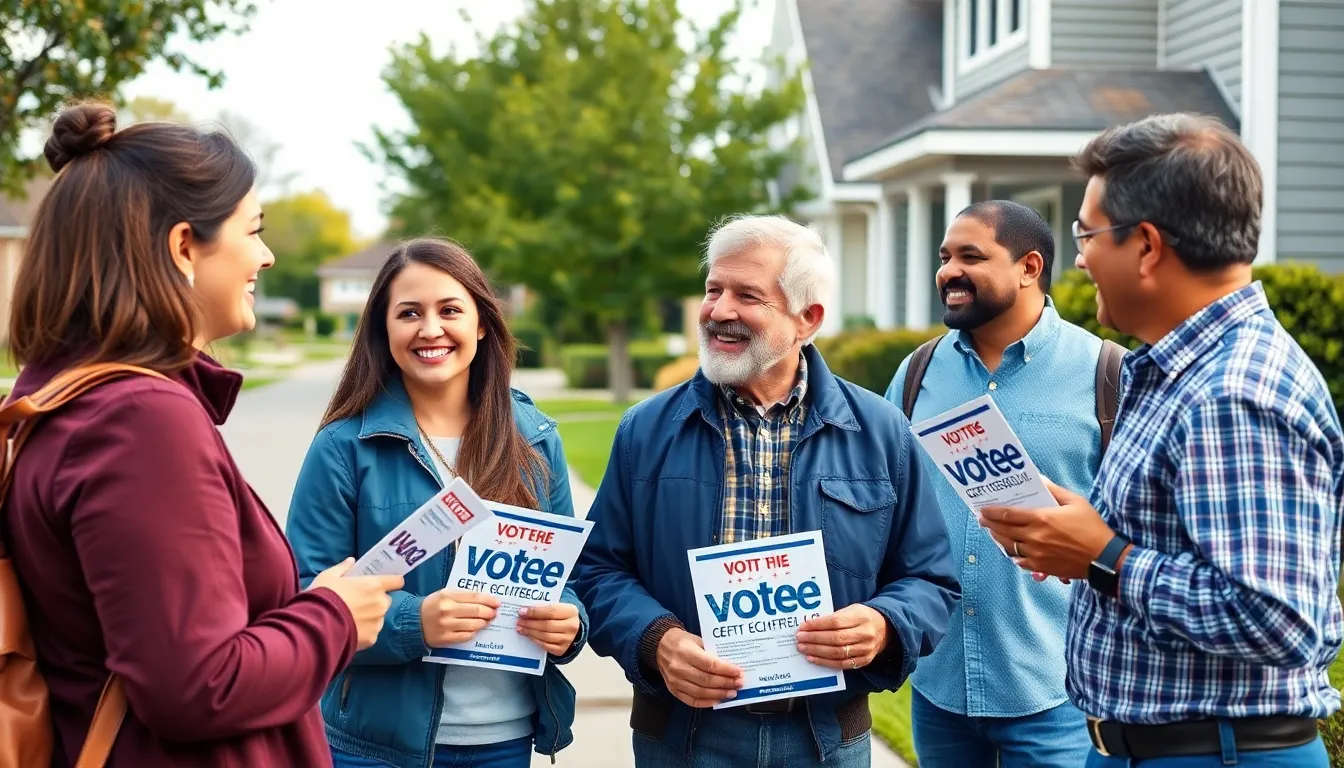Table of Contents
ToggleIn a world where political debates can get as heated as a summer barbecue, political canvassers are the unsung heroes armed with clipboards and a smile. They’re the brave souls who venture into neighborhoods, dodging doorbells and awkward small talk, all in the name of democracy. Whether they’re championing a candidate or rallying support for a cause, these dedicated individuals play a crucial role in shaping the political landscape.
Imagine knocking on a stranger’s door, armed only with charisma and a compelling pitch. It sounds daunting, right? Yet, political canvassers thrive on these challenges, turning potential awkward encounters into engaging conversations. With each knock, they’re not just collecting votes; they’re building connections and inspiring civic engagement. So, what does it really take to be a successful political canvasser? Let’s dive into the world of grassroots campaigning and discover the art behind those friendly faces at your doorstep.
Understanding Political Canvassing
Political canvassing plays a crucial role in democratic engagement. This process involves direct interaction between campaigners and voters, aiming to influence opinions and mobilize support.
Definition of Political Canvasser
A political canvasser refers to a person who actively engages with constituents to gather support for a candidate or issue. These individuals often go door-to-door, making phone calls, or utilizing social media platforms to communicate directly with voters. Canvassers listen to concerns, answer questions, and provide information about policies or campaigns. Their work relies on building rapport and trust, emphasizing personal connections over generic outreach methods.
Importance in Elections
In elections, political canvassers significantly impact voter turnout and campaign effectiveness. Research indicates that face-to-face interactions enhance voter engagement, with statistically higher turnout rates among contacted individuals. Grassroots movements often depend on canvassers to articulate candidate platforms clearly and compellingly. These efforts help candidates identify community concerns and adjust their strategies accordingly. By providing valuable insights and fostering personal connections, canvassers strengthen the democratic process, ensuring constituents’ voices are heard in the electoral landscape.
Types of Political Canvassing

Political canvassing encompasses various methods to engage with voters. Each type plays a crucial role in mobilizing support and influencing opinions.
Door-to-Door Canvassing
Door-to-door canvassing involves canvassers visiting homes within targeted neighborhoods. This method allows for personal interactions with constituents. Canvassers have opportunities to directly discuss candidates’ platforms. Engaging face-to-face often fosters trust and rapport. Studies show that this approach significantly boosts voter turnout. Local issues come to light during these conversations, enabling canvassers to address specific community concerns. Personalized messaging resonates effectively, as it tailors the conversation to voters’ needs.
Phone Canvassing
Phone canvassing provides a flexible alternative to in-person visits. Canvassers connect with voters using phone calls to convey campaign messages. This approach allows for efficient outreach to a larger audience. Personalized scripts ensure that key talking points remain consistent, while also allowing for spontaneous dialogue. Engaging voters over the phone can encourage participation, especially among those unable to meet in person. Data indicates that well-executed phone outreach enhances voter engagement and increases turnout, making it an essential strategy for campaigns.
Skills Required for a Political Canvasser
Political canvassers must cultivate essential skills to effectively engage with voters and influence opinions. Two primary skills include communication and persuasion.
Communication Skills
Effective communication lays the foundation for successful canvassing. Politically focused individuals articulate candidates’ platforms clearly. They listen actively to constituents, ensuring a two-way dialogue. Engaging storytelling captures attention and fosters understanding. Verbal and non-verbal cues also play significant roles in establishing trust. Practicing empathy helps canvassers connect with diverse populations. Finally, adapting communication style to different audiences enhances accessibility and relatability.
Persuasion Techniques
Persuasion techniques enable canvassers to inspire change. Establishing credibility fosters trust among constituents. Demonstrating knowledge about local issues showcases commitment. Using emotional appeals can resonate with voters more deeply. Framing information positively promotes candidate platforms effectively. Employing scarcity tactics highlights urgency in decision-making. Additionally, encouraging action through clear calls-to-action motivates voters to participate. By combining these strategies, canvassers increase their influence and contribute to a more engaged electorate.
Challenges Faced by Political Canvassers
Political canvassers encounter a range of challenges in their efforts to engage with voters. These obstacles can affect their ability to connect with constituents and maximize campaign outreach.
Dealing with Rejection
Rejection stands as a common challenge during canvassing efforts. Canvassers face many closed doors and dismissive responses. Staying positive in the face of negativity is crucial for maintaining momentum. Persistence often leads to productive conversations later on. Frequent practice does build resilience, helping canvassers manage emotional responses. Using this rejection as a learning opportunity can enhance future interactions. Support from fellow team members offers encouragement and motivation amid setbacks. Emotional intelligence also plays a vital role in overcoming feelings of discouragement.
Navigating Difficult Conversations
Navigating challenging conversations proves essential for political canvassers. Addressing contentious political issues demands careful preparation and strategy. Staying calm while engaging in discussions about sensitive topics helps establish a respectful dialogue. Active listening is key; it ensures canvassers understand constituents’ perspectives. Asking open-ended questions often encourages more in-depth conversations. Maintaining a neutral stance allows canvassers to guide discussions without alienating voters. Tailoring responses to address specific concerns shows attentiveness and genuine interest. Developing skills in conflict resolution strengthens a canvasser’s ability to turn difficult exchanges into constructive interactions.
Political canvassers are essential to the democratic process. Their direct engagement with voters not only fosters connections but also encourages civic participation. By utilizing effective communication and persuasion techniques, canvassers can navigate challenges and inspire meaningful conversations.
The impact of their efforts is evident in increased voter turnout and heightened awareness of community issues. As they continue to bridge the gap between candidates and constituents, political canvassers play a pivotal role in shaping informed electorates. Their dedication to understanding and addressing the concerns of their communities ensures that every voice is heard in the electoral landscape.








